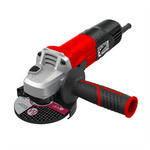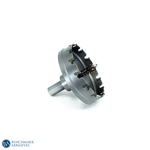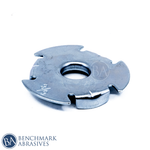
Grinding vs Machining: What’s the difference?

When it comes to metal fabrication and manufacturing, two main processes are used to remove excess material from a workpiece to achieve the desired shape, dimensions, and surface finish.
In metal fabrication and manufacturing, two primary processes are used to remove excess material from a workpiece. Machining and grinding are used to achieve the desired shape, dimensional accuracy, and surface finish. While both fall under the umbrella of subtractive manufacturing, they utilize distinct mechanisms and offer different outcomes, making the choice between them crucial for various applications.
Machining processes, including cutting, drilling, turning, and milling, are commonly employed for bulk stock removal with a high Material Removal Rate (MRR). They are excellent for achieving high-dimensional accuracy and close tolerances. The geometry of this cutting tool is well-defined. The cutting tools used in machining processes are made from carbon, steel, CBN (Cubic boron nitride), and diamond.
Grinding is primarily a method used for finishing surfaces. It boasts a lower MRR but excels in providing superior surface finish and even tighter dimensional accuracy. This process utilizes a circular wheel, also known as a grinding wheel, made up of sharp abrasive grains. The abrasive grains are bonded to the wheel with special adhesives. Grinding wheels remove material from the surface in the form of chips.
Understanding the fine distinction between these two fundamental processes is essential for anyone involved in manufacturing, engineering, or material science.
Grinding vs. Machining: Fundamental Mechanisms
The primary distinction between grinding and machining is the cutting tool used and the method of material removal.
Machining (Metal Cutting Processes):
- Mechanism: These processes shear material using a sharp-edged cutting tool with a well-defined geometry.
- Tools: Cutting tools are made from highly durable materials, such as high-carbon steel, tool steel, Cubic Boron Nitride (CBN), or diamond, each chosen for its specific hardness and application.
Grinding Process:
- Mechanism: Grinding uses a circular grinding wheel, which is composed of countless sharp abrasive grains (like ceramic, alumina, zirconia, or silica). These abrasive grains are bonded onto the wheel using special adhesives. During the grinding process, abrasive grains on the spinning wheel remove material from the surface in the form of very fine chips.
- Tools: The grinding wheel acts as a multi-point cutting tool with random, undefined geometry for its cutting edges.
Similarities Between Grinding and Machining
Despite their differences, grinding and machining share several fundamental characteristics as subtractive manufacturing processes:
- Subtractive Manufacturing: Both processes involve the removal of material from a workpiece (as opposed to additive manufacturing, which builds up material layer by layer).
- Cutting Tool Requirement: Both require a "cutting tool" or "cutter" (whether a defined insert or abrasive grains) to facilitate material removal.
- Chip Formation: In both processes, material is removed in the form of solid chips (though chip size differs significantly).
- Material Removal Order: Excessive materials are removed in a specific, controlled order to achieve the desired shape.
- Shearing Action: Both processes primarily involve shearing the material to remove it. Grinding, which includes processes such as "ploughing" and "rubbing," primarily removes material through shearing.
- Mechanical Energy: Traditional machining and grinding predominantly use mechanical energy to remove material. (Note: Non-traditional machining (NTM) processes can utilize electrical, mechanical, thermal, and chemical energy for material removal.)
Read: Types of Grinding Wheels
Key Differences Between Grinding and Machining
While both grinding and machining involve shearing and the removal of excess material in chip form, they differ significantly across several critical factors. The table below highlights the main distinctions:
| Factors | Grinding | Machining |
| Primary Purpose | Surface finishing, achieving high-dimensional accuracy | Bulk stock removal, shaping |
| (Material Removal Rate) MRR | Low MRR | High MRR |
| Tolerance & Dimensional Accuracy | Provides superior dimensional accuracy and very close tolerance | Generally lower tolerance and dimensional accuracy (compared to grinding finish) |
| Tool/Cutter Type | Grinding wheel made of numerous sharp, randomly oriented abrasive grains (ceramic, alumina, zirconia, silica, etc.) | Defined geometry cutting tool (sharp-edged cutter) made of hard metals, ceramics, CBN, or diamond |
| Abrasive/Tool Geometry | Abrasive grains have random/undefined geometry (no specific directions, orientation, nose radius, or edge definition) | Cutting tools have pre-defined geometry (well-defined directions, orientation, nose radius, and edges) |
| Rake Angle | It may vary from +75° to -75° | It may vary from +15° to –15° |
| Clearance Angle | Clearance angles can be zero or negative. | The clearance angle of the cutting tool cannot be zero or negative (usually varies from +3° to +15°). |
| Cutting Edge Participation | Only a small percentage (~1%) of abrasive grains participate in the cutting action at any given time | Each cutting edge of the tool directly participates in the cutting action |
| Shearing Process | Grinding involves shearing, ploughing, rubbing, and scratching during the process. | Machining mainly involves shearing during the process. |
| Specific Energy Consumption (power required per unit MRR) | High (due to significant energy loss from rubbing, ploughing, and scratching) | Low |
| Heat Generation | High heat generation. Grinding heat passes from the surface to the inside of the material and can cause thermal damage. | Low heat generation. During machining, only a small amount of heat is transferred from the surface into the material, with the majority being carried away by the chips. |
| Material Hardness | Cutting material toughness, hardness, and ductility do not significantly affect grinding efficiency. | Material hardness and ductility directly affect the cutting rate and tool wear. |
Read: Types of Metal Cutting Tools
When to Choose Grinding vs. Machining
The decision to use grinding or machining depends on the desired outcome and workpiece characteristics:
Choose Machining When:
- You need to remove a large volume of material quickly (high MRR).
- The required surface finish and dimensional accuracy are within standard machining tolerances.
- You are shaping rough stock into a basic form.
- The material is relatively softer, or you need to cut complex geometries.
Choose Grinding When:
- You need an exceptionally high surface finish.
- Extremely tight dimensional accuracy and close tolerances are critical.
- The workpiece material is very hard or brittle (e.g., hardened steels, ceramics, glass).
- Only a small amount of material needs to be removed (fine finishing).
- You need to correct heat treatment distortions.
Conclusion
Both grinding and machining are vital processes in modern manufacturing, important for removing material through subtractive methods. While machining is ideal for fast bulk material removal and shaping with defined cutting tools, grinding is utilized for achieving superior surface finishes and ultra-high precision, utilizing countless abrasive grains. Understanding these different mechanisms, the tools involved, and their respective advantages allows fabricators and manufacturers to select the most efficient and effective process for achieving the desired product specifications.



































































